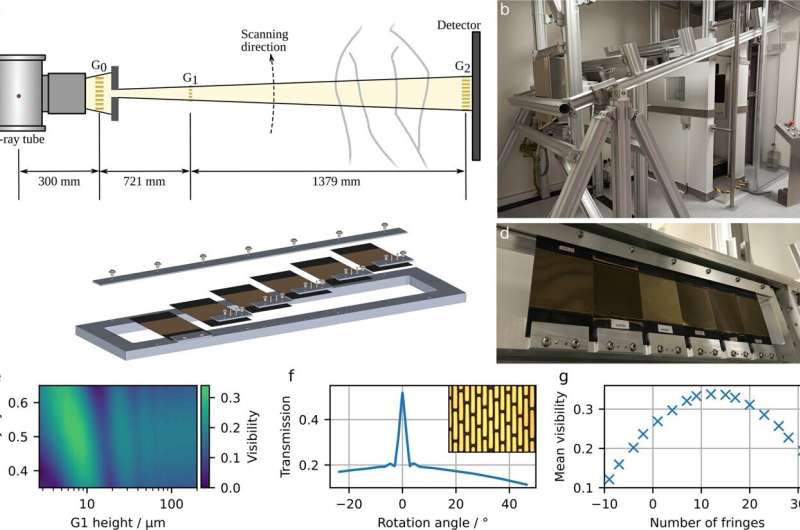Design and implementation of the dark-field chest X-ray prototype. a Schematic and b photograph of the prototype system, combining a conventional radiography setup with a three-grating X-ray interferometer. c Schematic and d photograph of the G2 grating holder allowing individual positioning of the gratings as well as bending of the gratings according to the cone-beam geometry. Bending prevents the shadowing of the gold bars of the high aspect ratio gratings. e Simulated visibility for optimizing of grating parameters such as duty cycle and height. The optimization was carried out iteratively for all three gratings. f Angular X-ray transmission measurements and scanning electron microscopy image (inlet) for one of the grating structures. g Influence of a number of fringes per frame on mean interferometric visibility. Credit: Communications Medicine (2022). DOI: 10.1038/s43856-022-00215-3
A research team at the Technical University of Munich (TUM) has, for the first time, produced dark-field X-ray images of patients infected with COVID-19. In contrast to conventional X-ray images, dark-field images visualize the microstructure of the lung tissue, thereby providing additional information. This approach has the potential to provide an alternative to computed tomography (CT), which requires a significantly higher radiation dose.
The lungs of COVID-19 patients are normally visualized using computed tomography (CT). CT technology uses multiple X-ray images from different angles to compute a three-dimensional image. This provides more accurate results than two-dimensional imaging using conventional X-ray technology. The downside, however, is a higher radiation dose due to the large number of X-ray images required.
Dark-field chest X-ray is a new X-ray technology developed by Prof. Franz Pfeiffer. It is paving the road for new possibilities in radiological diagnostics: "During our X-ray examination, we take conventional X-ray images and dark-field images simultaneously. This gives us additional information about the affected lung tissue quickly and easily," says Franz Pfeiffer, Professor of Biomedical Physics and Director of the Munich Institute of Biomedical Engineering at TUM.
"The resulting radiation dose is fifty times smaller compared to CT machines. Consequently, this method is promising for application scenarios that require repeated examinations over extended periods of time—for example, when investigating the progression of long COVID. This approach might serve as an alternative to computed tomography for imaging lung tissue over prolonged observation periods," Franz Pfeiffer explains further.
Additional information on lung tissue microstructure
In a new study, published in the journal Communications Medicine, radiologists compared the images of patients with COVID 19 lung disease to those of healthy individuals. They found that distinguishing between sick and healthy individuals was easier using dark-field images than conventional X-ray images. The radiologists were able to differentiate between diseased and healthy lung tissue most readily when both kinds of images—conventional and darkfield—were available.
While conventional X-ray technology relies on the attenuation of X-rays, dark-field X-ray technology utilizes so-called small-angle X-ray scattering. This opens the door to garner additional information on the nature of lung tissue microstructure. Dark-field images can thus provide added value when investigating a variety of lung diseases.
Quantitative evaluation
The research team optimized the X-ray machine prototype to allow them to evaluate the images quantitatively. A healthy lung with many intact alveoli produces a strong dark-field signal and appears bright in the image. In contrast, inflamed lung tissue, with embedded fluid, produces a weaker signal and appears darker in the image. "We normalize the dark-field signal with regard to lung volume to account for lung volume variations between individuals," explains Manuela Frank, a lead author of the paper.
"Next, we hope to examine further patients. Once we have sufficient dark-field X-ray data available, we intend to use artificial intelligence to support the evaluation process. For conventional images, we have already carried out a pilot project for AI evaluation of our X-ray images," says Daniela Pfeiffer, professor of radiology and medical director of the study at the TUM University hospital Klinikum rechts der Isar.
More information: Manuela Frank et al, Dark-field chest X-ray imaging for the assessment of COVID-19-pneumonia, Communications Medicine (2022). DOI: 10.1038/s43856-022-00215-3
Journal information: Communications Medicine
Provided by Technical University Munich
























